I was so careful. I gave myself a list of 8 titles without committing to any. But my fate was sealed in a single sentence:
“Even I ought to be able to write one Jazz Age post in June…”
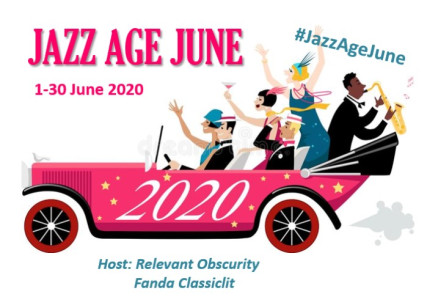
Sadly, Jazz Age June has come and gone and we’re past the midpoint of the next month. But Jazz Age July has a certain ring to it and if Laurie and Fanda will permit it, I have a post or more to contribute on the basis that late is better than never.
First up, a ramble about children’s books in the Jazz Age, perhaps more appropriately, children’s books in the Twenties since I’m struggling to connect children’s literature with what I typically think of as ‘Jazz Age’. When I think of the Jazz Age I see the Roaring Twenties, Bright Young Things, the Lost Generation. I think of Fitzgerald and Hemingway, of Modernism and the Harlem Renaissance.
I don’t think at all of children’s literature, although there was plenty to celebrate in that decade. In America the Newbery Medal was established in 1921 to encourage “quality, creative children’s books and to demonstrate to the public that children’s books deserve recognition and praise“. (The United Kingdom didn’t catch on until 1936 when the Carnegie Medal was introduced.) As a Brit, I hope I’m forgiven for recognising only one of the Newbery winners from that first decade of the award, who was himself British. Hugh Lofting’s The Voyages of Dr Dolittle was the second in the Dolittle series and won in 1922; the first volume was published in 1920 and there were several more later.

Many newer editions are ‘edited for modern audiences’ to address what would now be received as racial slurs and stereotypes, and having searched for some illustrations for this post, I can see why amendments are necessary. That said, I note there was a centenary edition published in 2019 which has retained both Lofting’s original illustrations and the original text.
I have not read any Dr Dolittle books in any edition. But I have read the highest-ranking children’s book of the decade according to Goodreads’ list for the 1920s. Winnie-the Pooh (1926) by A A Milne appears at no 4 (just three below The Great Gatsby which is sitting pretty in the top spot). The other four children’s books published by Milne in the twenties are all in the top 60.
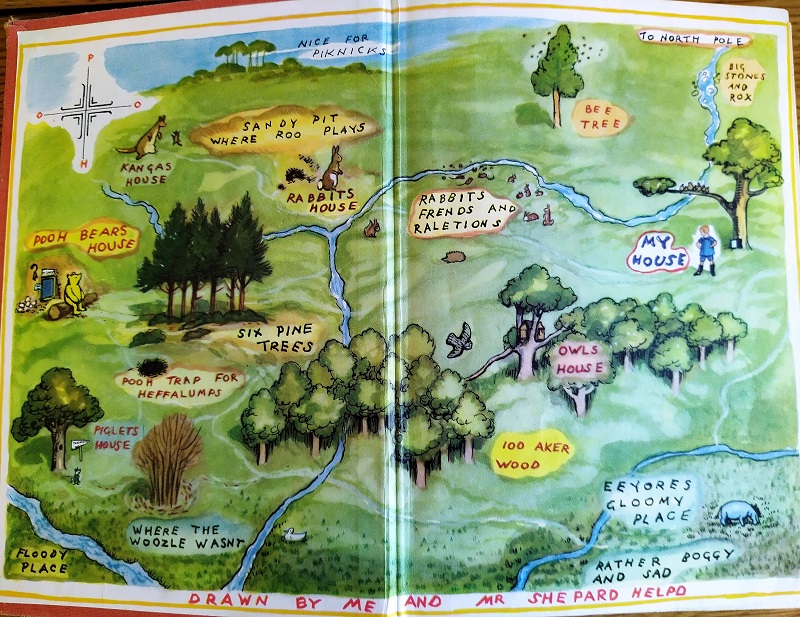
My copy of Winnie-the-Pooh is very special to me. I’ve had it since I was ‘very young’, to borrow from another Milne title. It’s a hardback which somehow made it very important indeed at the time I was given it and of course it features E H Shepherd’s marvellous illustrations depicting the adventures of Pooh and friends in the Hundred Acre Wood. No problems with the original illustrations here unless we care to consider the spelling. I’m trying to ignore the question of apostrophes…

There is a centenary edition of Winnie-the-Pooh available but I am more than happy with my battered old copy from 1966. The dust jacket was torn and lost many years ago but it still has its gold lettering on the spine, just about visible. Once it was sparkly and bright. Surely – to my 7-year-old thinking – a further indication of what an important book it was!

It was an anxious moment… 
Eeyore picked the balloon up carefully…
Other personal highlights from children’s literature in the twenties include L M Montgomery’s Emily series – which I read as an adult and which might just have the edge on the later books in the Anne series – and the early Milly-Molly-Mandy books by Joyce Lankester Brisley. I read all the M-M-M books as a child and had a peculiar love-hate relationship with the little girl in the candy-striped dress. (Lucy Mangan writes lovingly about these books in the wonderful Bookworm. I have a post in draft about Bookworm which has been waiting for months. I’ll click ‘publish’ eventually!)
Thinking about these favourites made me question my decision to include The Velveteen Rabbit by Margery Williams Bianco on my Jazz Age list of possible reads. I hesitated because at a mere handful of pages, it can scarcely be considered a book. (This post is probably longer than the book!) The idea of making a blog post around it seemed absurd. But it features at no.23 on Goodreads Best Books of the Decade, (Dolittle first features at no. 69); it’s remained a children’s classic since its publication in 1922 and I’ve promised myself an adult reading of it for a long time. Winnie-the Pooh, Emily, Dr Dolittle and Milly-Molly-Mandy were set aside in favour of this quaint little gem from the nursery.

The Velveteen Rabbit or How Toys Become Real is Margery Williams Bianco’s most famous book. An English-American who married an Italian bookseller, she became a published writer of adult novels aged 19 but met with with no great success. She stepped back from writing to raise her children. The last book published before she took her break was a horror novel, The Things in the Woods, known to H P Lovecraft, who wrote a poem referencing Williams’ novel and may have drawn upon it for one of his own books.
The Velveteen Rabbit was her first book for children on her return to writing and she wrote many more. Later, she began writing for young adults and included themes which would not be out of place today, such as young carers and choosing to work for financial independence over going to college. Increasingly influenced by the onset of World War II, her final book, Forward, Commandos! was published shortly before her death and included amongst its inspirational characters an African-American soldier. Again, ahead of her time. Margery Williams died in 1944, aged 63.
Williams is associated with the sentimental, the twee, the melancholic – The Velveteen Rabbit embodies all of this – but it would seem that she had a wider range than trite little books for the nursery. And within Rabbit there is a theme and purpose behind the whimsy.

Williams was inspired by watching her children’s imaginative play and regarded the poet and author, Walter de la Mare as her ‘spiritual mentor’. In a 1919 lecture on Rupert Brooke and the Imagination, de la Mare argued for two forms of imagination: the childlike and the boylike. (He claimed that the genius of Shakespeare and other great poets – presumably Brooke – lay in the border between the two.) Young children are characterised by the childlike imagination. De la Mare argued that facts, for young children are “… the liveliest of chameleons”. Children, he says, are “visionaries” in their creativity and capacity to see beyond the facts. But with age and inevitable influences from the external world, most children lose this aspect of their creativity or at best adapt it. The childlike imagination retreats, “… like a shocked snail into its shell“, and the intellectual and analytical ‘boylike’ imagination predominates. Perhaps, among the best children’s writers of any age, the snail withstands the shock and does not retreat into its shell. Perhaps that is the case among all great writers.
(No mention is made of girls in this source. How interesting it would be to learn whether girls also had ‘boylike’ imaginations. Perhaps de la Mare saw them as entirely deficient in intellectual and analytical prowess? Did they simply retain their childlike imagination into adulthood, or perhaps they had no imaginations at all?)
Williams’ whimsical stories now have a context. She appeals to the childlike imagination, where facts are fluid and children have open minds and no concerns at all about talking toys.

The rabbit in question is stuffed into a Christmas stocking, and is much-loved for a short while by a delighted small boy until his attention is caught by other, more exciting, mechanical toys. Ignored in the nursery and mocked by the other toys, the rabbit is a patient and loyal creature who endures the teasing and finds solace in the wisdom of the oldest toy in the nursery, the Skin Horse (who has his own story published in 1927). The rabbit is curious and asks the Skin Horse what it is to be real.

Komako Sakai (2012) 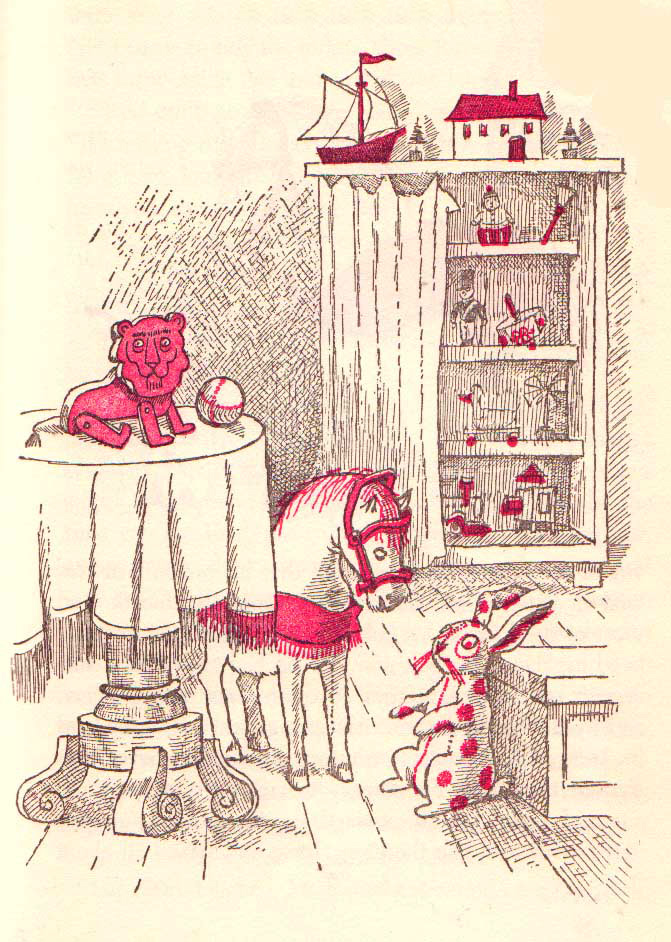
Maurice Sendak (c. 1960)
Here is perhaps the most quoted extract from The Velveteen Rabbit:
“Real isn’t how you are made,’ said the Skin Horse. ‘It’s a thing that happens to you. When a child loves you for a long, long time, not just to play with, but REALLY loves you, then you become Real.’
‘Does it hurt?’ asked the Rabbit.
‘Sometimes,’ said the Skin Horse, for he was always truthful. ‘When you are Real you don’t mind being hurt.’
‘Does it happen all at once, like being wound up,’ he asked, ‘or bit by bit?’
‘It doesn’t happen all at once,’ said the Skin Horse. ‘You become. It takes a long time. That’s why it doesn’t happen often to people who break easily, or have sharp edges, or who have to be carefully kept. Generally, by the time you are Real, most of your hair has been loved off, and your eyes drop out and you get loose in the joints and very shabby. But these things don’t matter at all, because once you are Real you can’t be ugly, except to people who don’t understand.”
That’s a powerful analogy whatever age the reader.

The rabbit’s loyalty and love for the boy remains constant across the years and through various traumas. He meets wild rabbits, who mock him for his lack of hind legs and his inability to leap and dance as they can. His fate appears doomed when the boy recovers from scarlet fever and all his toys must be burnt for fear of infection. Thankfully, despite the melancholy which permeates the tale, Williams doesn’t shirk from giving the rabbit’s story a happy ending. No intellectual, ‘boylike’ imagination to be found in the finale!
Williams lost her father at the age of 7, a loss which runs through her books. She argued that pain and adversity can lead to greater humanity. She believed that life is a constant process of change – of departures and arrivals. These are the means through which we grow. A truth still very much relevant in these uncertain times, which makes me glad that 100 years on, I decided to include this little book in my Jazz Age Jaunt.
Read for Jazz Age June, the Classics Club and no. 3 for my 10 Books of Summer


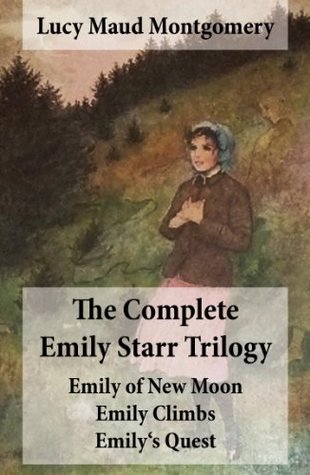


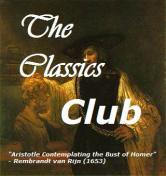
What a lovely and informative post, you’re so lucky to have your old copy of Pooh, I’m envious.
LikeLiked by 1 person
Glad you enjoyed it, Katrina 😊 I have very few of my childhood books. This one is very precious.
LikeLike
All familiar save the Milly series. We had “Betsy, Tacy and Tib” which I read and reread. I have my mother’s Winnie the Pooh, and I haven’t checked to see how old it is. She was born in 1922, so it may be quite old. I quote Milne so often that I forget that everyone didn’t memorize it all as a child. “Now I’m six I’m as clever as clever, so I think I’ll stay six now forever and ever” still speaks to me!
LikeLiked by 1 person
How lovely to have your mother’s copy. I imagine it is quite old and undoubtedly special. Milne’s words are wonderful as are Shepherd’s illustrations. I got lost in flicking through my old book again. I must get it out more often 😊
LikeLike
I haven’t read The Velveteen Rabbit though the story sounds vaguely familiar. Pooh on the other hand was and still is a favourite, though secretly I prefer Eeyore, whose outlook on life I feel is much more in line with my own. As for Tigger – bah! Thinks he’s great just because he can bounce! So like a boy…
LikeLiked by 1 person
I wonder if there is anyone who doesn’t like Pooh – or at least one of his friends? I have a lot of sympathy with Eeyore but I think rabbit may be closer to me in character 😄
LikeLiked by 1 person
A beautiful post! I’ve read the Velveteen Rabbit, and Winnie the Pooh and loved them. Among other favorites from back then were Uncle Wiggily (another rabbit tale), and My Friend Flicka.
LikeLiked by 1 person
Lavinia, I loved all the Flicka books too! Also the Silver Brumby series which was set in Australia. I had a long period of reading pony books, even non-fiction at times. Yet I’ve grown up very wary of horses!
LikeLiked by 1 person
Silver Brumby – now I know I would have loved that series! I grew up around horses, and had a pony, and a horse way back when. Yes, they are big and can do some bodily damage when they spook.
LikeLiked by 1 person
Really enjoyed this post! How wonderful to still have that book from 1966. Has anything else made it with you from 1966? I liked the Emily series, too.
LikeLiked by 1 person
Glad you enjoyed it, Laurie. I have very few books from my childhood but one or two paperbacks are still with me, probably from a similar year. The Little Princess by Frances Hodgson Burnett was a favourite, also The Silver Sword by Ian Serraillier, which was published in N America as Escape from Warsaw, I think. Two more different books I can’t imagine!
LikeLiked by 1 person
Another sumptuous post which I have read a couple of times, wallowing in nostalgia and new information about these famous titles – fascinating. And what a lovely treasure to have that beloved copy of WtP.
LikeLiked by 1 person
I enjoyed myself putting this one together, Liz. Very indulgent 😊 My beloved Pooh is indeed a treasure and it was so nice to have it out while compling this post. I had almost forgotten just how wonderful Pooh’s world is!
LikeLiked by 1 person
If we can’t indulge ourselves on our own blogs……! And by coincidence, this link came up in on Facebook over the weekend. I know that it is so much better to have the physical book in one’s hands, especially with children’s books, but isn’t it amazing what we have access to these days 🙂 http://www.openculture.com/2020/03/digital-archives-give-you-free-access-thousands-of-historical-childrens-books.html
LikeLiked by 1 person
Oh my goodness, Liz, thank you for this link! I shall certainly be looking into it further. It’s hard to imagine how we ever got along without access to such immediate and diverse resources!
LikeLiked by 1 person
I’m so pleased that you are pleased! 😀
LikeLiked by 1 person
As a fellow Lucy Mangan fan, I really enjoyed this post. This bookish child never read Doctor Dolittle, or indeed the Velveteen Rabbit, but I was brought up on Winnie the Pooh, and to a lesser extent on Milly-Molly Mandy. Of these, only Winnie-the-Pooh and friends seem to have been introduced to my grandchildren.
LikeLiked by 1 person
I thought of you when I mentioned Lucy Mangan. I’m sure the same applies to my grandsons too. Pooh seems to have universal appeal. I am hoping (fingers crossed) to see my grandsons next month. Maybe I’ll share my precious Pooh book with them 😊
LikeLiked by 1 person
Oh, do! I’m sure they’ll appreciate the history of your book (though come to think, I don’t know how old they are). Grandchildren have been far too absent in our lives lately, haven’t they?
LikeLiked by 1 person
7 and 10, so actually the youngest will be age I was when I was given it. I shall keep it out in readiness. Maybe won’t leave it in their room overnight though…
And yes – absent for much too long. The eldest will have shot up at least another 6 inches!
LikeLiked by 1 person
Our little Zoe won’t remember me at all, when you’re only 23 months old, 5 months is a big chunk of lifetime 😦
LikeLiked by 1 person
Oh gosh, yes. And she’s probably too young to use Zoom! So much disruption from this virus. Children are so adaptable though. When my two were infants, I saw them infrequently but we still built up a relationship. You will have to backtrack a bit but it won’t take long before she’ll know you again just as she did before 😊 She won’t remember this absence; it will be you who is aware of what you have missed in her development 😒
LikeLike
Thanks for this post, Sandra, it has brought back many happy memories. Somehow, I never encountered the Velveteen Rabbit until I was an adult, but I still have a lot of affection for Winnie the Pooh, as it is one of the first stories I remember being read to by my mother. I’m also glad it’s not just me who had something of a love/hate relationship with Milly-Molly-Mandy, I think I would find her unreadable nowadays.
LikeLiked by 1 person
I’m so glad you enjoyed it, Alyson 😊 Like you, I have no desire to revisit M-M-M although I would like to know why I persisted with her books when I know I didn’t really enjoy them. And as with you, The Velveteen Rabbit was an adult discovery for me. But Pooh just seems to appeal to everyone across the years. I’ve yet to meet anyone who doesn’t have fond memories of Pooh and his friends.
LikeLike
Well, at least I’ve read The Great Gatsby
LikeLiked by 1 person
And Winnie-the-Pooh, surely? If not, Derrick, I urge you to consider reading it to Ella when she’s a little older 😊
LikeLiked by 1 person
I’ve never actually read all of Winnie the Pooh – but lots of sections 🙂
LikeLiked by 1 person
I’m sure that counts. You have no doubt read all the important parts!
LikeLike
Enough to inspire this, Sandra: https://derrickjknight.com/2012/08/21/pooh-sticks-2/
LikeLiked by 1 person
Derrick, what a charming post! Thank you for directing me to it 😊
(I knew you would have read the important bits! 😉 )
LikeLiked by 1 person
🙂
LikeLiked by 1 person
What an interesting look at the 1920s! I didn’t read Pooh till I was a grown up but I still loved him! 😀
LikeLiked by 1 person
Everyone loves Pooh! Someone somewhere must have produced a dissertation on the universal appeal of Pooh! 😆
LikeLiked by 1 person
What a fabulous post, thank you! The illustrations (all of them) are beautiful.Milly Molly Mandy has a very special place in my book life, I’m not really sure why except that she was always around! And such a good idea to choose children’s books from the ’20’s , I never think of them as being so old.
LikeLiked by 1 person
Thank you, Jane 😊 I know what you mean about the concepts of old and time and books. I got quite a shock when I realised that my Pooh book was printed 40 years after the original publication and yet the book itself is almost 100 years old. There’s a mismatch in my head – a lost 60 years!
LikeLike
This was certainly worth waiting for. Thank you!
I have not read most of these books, not Winne the Pooh, not the Velveteen Rabbit. And I am only familiar with the Dr. Doolittle films….But I redeem myself with the Emily series, by LM Montgomery. I did not read any of the Anne books until I was an adult and an astute friend told me I would like the Emily books better. She was so right. Emily Byrd Starr is a special young heroine of mine.
LikeLiked by 1 person
I’m pleased you enjoyed it, Laurie. All being well there will be a couple more 20s posts on other books before the end of this month 🤞
I also only encountered Emily quite recently and found her delightful. We share a heroine in Miss Starr!
LikeLike
Gorgeous! This post made me smile the whole way through. I bet if the house was burning down you would run in to save your beloved copy of Winnie the Pooh.
LikeLiked by 1 person
Funnily enough, my book lives on a bookshelf right beside the front door. It wasn’t intentional but now you’ve pointed it out, I think it’s the perfect place to keep it. Just in case!
LikeLiked by 1 person
🙂
LikeLike
I would commend to you The Velveteen Daughter by Laurel Davis Huber, a very interesting novel about Margery and her daughter.
LikeLiked by 1 person
Rebecca, thank you! I wouldn’t have found this without your recommendation and yes, I’m sure I will enjoy it very much. Available on Kindle for 99p at the moment too!
LikeLiked by 1 person
I recently downloaded Winnie the Pooh because to my knowledge, I’ve never read it, which seems such a shame! Nor the Velveteen Rabbit, though I have heard those quotes from it. One of my favourite older books – from 1942 -was Gobbolino the Witch’s Cat.
LikeLiked by 1 person
I liked Gobbolino too, although for reasons lost in the mists of time, I think of it alongside my sister. Perhaps I read her copy. Winnie-the-Pooh embodies a world of innocence, freeedom and friendship. A charming read at this time, I think, Andrea. I hope it makes you smile 😊
LikeLiked by 1 person
I don’t know if this book is considered to fall within the parameters of the Roaring Twenties, however, it was a book of my mother’s when she was a child. She was born in the fading minutes of 1927 (11:45 PM on December 31). The book is Clematis by Bertha B. and Ernest Cobb. When I was a little girl, my mother told me how much she loved this book as a wee one. It was published in 1917.
Mum also told me that it was the first time she had ever heard of the name Deborah and that I was named after a character in Clematis. Mum was in her 60’s when I began searching for the book. It took me 20 years to actually find it in an e-book format. I downloaded it to my Kindle and read this sweet story about an orphan girl. I was so excited to be able to share with my mother a memory from her childhood. I left my kindle with Mum for a few days so she could read it. She was delighted to reread this special book from her childhood. Both Mum and I had the best laugh. Because, you see, the character in the book, for which she named me, is a cat.
LikeLiked by 1 person
What a marvellous story, Deb, and such a precious memory to share with your mum. In turn, it has created a special memory for you too 😊 I see Clematis is now available on Gutenburg – how much more difficult it was to find such books back in the day. As for being named after a cat – I would feel very proud of such a pedigree! (So long as the cat wasn’t named Whiskers or or Peachblossom…. 😆 ) I shall read Clematis for myself now and think of you and your dear Mother as I read x
LikeLike
Ah, my English Cousin, you are so right. Mum had forgotten over the course of 7 decades that the character was a cat. It tickled me to no end. Thanks for allowing me to share the origins of my first name.
LikeLiked by 1 person
What a glorious selection of thoughts and illustrations. I’m so glad you’ve decided to extend this Jazz age to July.
You’ve definitely got the best copy of Pooh, and you’ve tempted me to seek out The Velveteen Rabbit – which I’ve missed out on.
LikeLiked by 1 person
Thanks Cath, yes, I’m very partial to my copy of Pooh! Enjoy Rabbit! 🐰
LikeLiked by 1 person
I wouldn’t connect children’s literature with the Jazz Age either, but this post turned out to be a small treasure of information (and nostalgia!). I actually have a reread of Winnie The Pooh on the agenda for a future posts (my head is full of ideas for future posts, so let’s see if this one materialises…). My mother read Winnie The Pooh back in the days, but unfortunately she doesn’t have her copy anymore.
LikeLiked by 1 person
I do hope a post materialises from your re-read of Pooh, Stargazer. But I know what it’s like to have a head full of blog ideas! 😆
LikeLiked by 1 person
I still have my Complete Winnie the Pooh book from my childhood … I’m reading it to my little daughter at the moment 🥰
LikeLiked by 1 person
Such a special moment, to share your own childhood treasures with your children 🤗
LikeLike
I really enjoyed this, thank you Sandra. I had two Pooh books when I was small – Shepard illustrations but black-and-white line drawings, no colour as in your copy. I had one M-M-M book that had been my mother’s when she was a child. Also line drawings but some were coloured by my mother using water-mixed paints when she was a child. (You might like to see my post referencing this – the link is below.) I still have this book. I remember thinking that M-M-M was curiously solemn but I loved the tree house and their cheerful kitchen with a hearth. I understand why you had mixed feelings about her. The Emily and Velveteen Rabbit books are new to me. Doolittle I only know from the movies. (Of course I have read Gatsby – and seen the movie with Robert Redford as Gatsby, but not the more recent one.)
https://naturebackin.com/2016/12/04/close-to-nature-the-english-countryside-in-three-childrens-books-from-the-early-20th-century/#more-1467
LikeLiked by 1 person
So glad you enjoyed this one, Carol. And thank you for directing me to your lovely equivalent post. I’ve just been lingering over those illustrations! I’d forgotten Little-Friend-Susan from M-M-M!
LikeLiked by 1 person
The illustrations really are compelling. Even those line drawings convey a richness of detail and expressiveness.
LikeLiked by 1 person